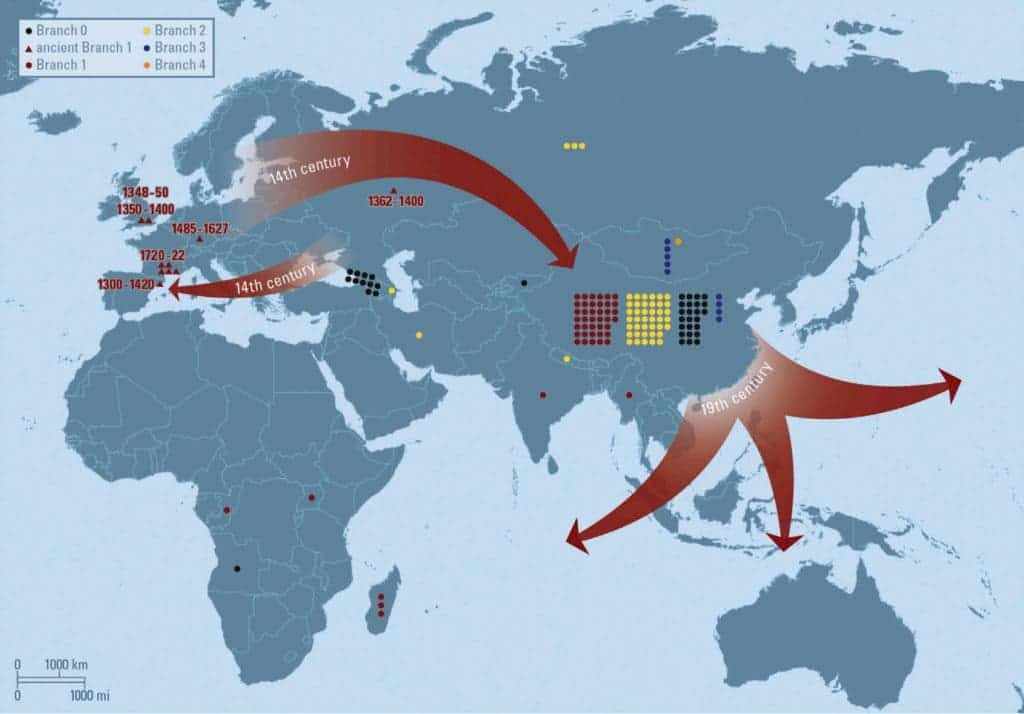
In October 1347, 12 Genovese trading ships docked at the Sicilian port of Messina after a long journey through the Black Sea. Those who greeted the ship weren’t expecting what followed next: most of the sailors aboard the ship were dead, and the few who could muster the strength to sail to safety were gravely ill. Land lovers naturally came to their rescue, trying to treat this fever which made the sailors gravely delirious, but also covered their bodies with black boils that oozed blood.
Within a week, the sailors were dead, and not long after most of the Messina townsfolk would come to learn first hand what bearing the disease is like. This highly infectious disease quickly spread from Messina throughout Europe killing over 20 million people in Europe in the next five years. This was the Black Plague, and for centuries the disease would outbreak, recede, then strike again keeping Europe and Asia in a state of constant terror until the late XIXth century.
In 2010, scientists came to the definite conclusion that the Black Plague or bubonic plague was caused by the Yersinia pestis bacterium, with stowaway rats on merchant ships acting as carriers. A debate still remained unsettled: was the disease flared up by new strains which mutated elsewhere, like in China, or did the pathogen went through periods of dormancy, activating only when the conditions were ripe?
To get to the bottom of things, a team of Russian, German and French researchers had to disturb Medieval tombs. Three mass grave sites were identified as a good fit for the study: one in Barcelona, one of the first cities to be hit by the plague, one in Bolgar City in eastern Russia, where the plague emerged a bit later, and the last one in Ellwangen, Germany, where the plague sewed panic almost a century after the first outbreak.

Y. pestis DNA was still found in 32 individuals, which researchers used to perform a genome-wide analysis. After the sequence was complete, the results were compared with previous genetic investigations of the bacterium in London and Marseilles.
The strain that hit Barcelona was identical to the one that hit London around the same time. The Y. pestis strain that hit Russia a bit later was almost identical, apart from some slight mutations that had arisen past this point. As for the samples from Germany and Marseilles, which are correlated with a later bubonic outbreak, the bacterium was directly related to the same strain from Barcelona.

The findings do indeed suggest that the Black Plague must have been dormant, even for decades if it had to, and was caused by the same strain of bacterium — not new invasions from novel rat-borne bacteria.
A phylogenetic tree was charted, then used to map how the killer Y. pestis strain moved throughout the old continent, then traced an arc that led into Russia, before ultimately completing a rough circle by re-entering Asia, its breeding ground. Indeed, historical records show that the third major reappearance of the plague happened in China in the 19th century.
Modern sanitation and public-health practices have greatly mitigated the impact of the disease but have not eliminated it. You might be surprised to hear, for instance, that 15 cases of bubonic plague were reported in the United States last year. The plague can be successfully treated with antibiotics, but only with a prompt diagnosis and treatment. The death rate is 16% among patients who have been treated and between 66% and 93% among those who are not treated, according to the CDC.
The full paper, titled “Historical Y. pestis Genomes Reveal the European Black Death as the Source of Ancient and Modern Plague Pandemics” was published online in the journal Cell and is available here.






